Lord Muck's Blog
December 9, 2015
American artist Theaster Gates sprung to peoples notice with his work on urban regeneration-meets-art projects on Chicago’s South Side. Since then he’s worked in Istanbul and Kassel, Germany amongst other places. In November he staged ‘Sanctum’ in a ruined church in Bristol. The Temple Church has been left unrestored since it was destroyed in the Blitz in November 1940.
In ‘Sanctum’, Gates created a performance space inside the shell of the church, a space that hosted 24 days of music, song, and spoken word, 24 hours a day. And what a space it is. Built from salvaged beams, old bricks, 18c floor planks and old doors and windows; it is part Hobbit home, part inverted wooden ship and part gigantic allotment shed.  Lord and Lady Muck and friends got to visit on the afternoon of the final day. A beautiful, sunny, and cold day.
Lord and Lady Muck and friends got to visit on the afternoon of the final day. A beautiful, sunny, and cold day.  The church itself, hardly ever open to the public – some of the structure isn’t safe, is a bleak reminder of the horrors of war visited upon a city that suffered more than its fair share of bombing 75 years ago.
The church itself, hardly ever open to the public – some of the structure isn’t safe, is a bleak reminder of the horrors of war visited upon a city that suffered more than its fair share of bombing 75 years ago.
Inside, Gates has created something both provisional and eternal, turning dead space into something alive. Alive that is with the continuous performances. It is all a bit chaotic – as it should be. Admission is free so just turning up and queuing is how it works – probably not much of a queue at 5am on a weekday morning, but what unexpected joy might there be then? A harpist perhaps or a singer. Turning up at any time it could be a ‘famous name’, (Mercury Prize nominees Slaves appeared at one point) or more likely a mash up of Bristol bands and singers, poets, speakers, or performers. You can stay for an hour, and groups are admitted at 20 minute intervals at busy times, leading to a sense of the sea, as a gentle tide of people empty and fill the space as their time-slots commence or expire. The space is small, welcoming and flexible. Bristol-based singer Julia Turner was on to entertain the Muck party, with her fellow performer violinist Annalise Lam.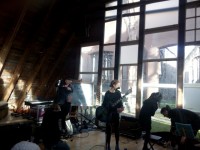 ‘Girl with a trumpet’ was one of their star turns (you can check out the actual performance on You Tube) and they performed a couple of Bill Withers numbers too (as in, ‘how do you turn in a duck into a great blues musician?’ ‘You put it in the microwave till its bill withers’) but the one that touched our hearts was ‘My Victorian boy friend’.
‘Girl with a trumpet’ was one of their star turns (you can check out the actual performance on You Tube) and they performed a couple of Bill Withers numbers too (as in, ‘how do you turn in a duck into a great blues musician?’ ‘You put it in the microwave till its bill withers’) but the one that touched our hearts was ‘My Victorian boy friend’.
Meantime children played on the wooden structures that cover the stones that mark the remains of the original 12c Knights Templar church and we gazed in awe at the quality of the workmanship that went into the construction of this supposedly temporary venue. A temple to allotment sheds world wide, right there in the Temple Church.
A temple to allotment sheds world wide, right there in the Temple Church.
September 14, 2015
As the political class digest the implications of Jeremy Corbyn’s landslide win in the Labour leadership elections it seems appropriate to remind ourselves of the importance of his allotment in his political trajectory. Throughout the leadership election campaign Lord Muck was reminded of our similarities: ‘..but Martin he rides a bike, makes jam, and has his own allotment!’ What is this supposed to tell us? That Lord Muck should lead the Labour Party? No thanks.
Instead let us turn to the real story. Jeremy Corbyn’s allotment. The media has made a few passing and often dismissive references to the allotment – mostly of the ‘well he can always retire to his allotment if he loses’-type comments. He didn’t lose, so now the allotment assumes a much greater political salience. Of course we have been there before – in fiction. Remember Chance, the Peter Sellers figure in the film ‘Being there’? The humble gardener who who determines Presidential policy in the White House, on the basis of his observations about the weather and the seasons. Now we have the chance to watch nature imitate art.
But back to that allotment. Where is it ? In East Finchley, north London. How long has he had one? About twelve years; to be precise since March 2003. Apparently his name came up on the waiting list a week or so before the invasion of Iraq – so that spring planting and digging season got missed. Most important, what does he grow? According to an interview in The Independent on 9 August – the only interview to take his interest in allotments seriously, this year he is growing potatoes, beans, soft fruit and apples. Good choice. Its been a great year for all of them. The Indy quotes his gardening style thus: ‘I try to grow things that don’t require a lot of watering because I don’t get up there regularly enough. But I always make time for my allotment. You like a dry summer because the weeds don’t grow. You water what you need to water and the weeds can sod off.’ For a busy gardener its a technique that works – most of the time – as long as you don’t want to grow anything like lettuces. But then he is clear he doesn’t. How has it influenced his policy positions? This still remains to be seen but he has argues that Labour should build houses with gardens for everyone so that ‘anyone who wants to be a beekeeper should be a beekeeper’ (his environment policy is strong on protecting bees). I don’t recall that as being the wellspring of previous Labour housing policy. And the jam? In an interview in the ‘Sunday People’ he refers to making ‘apple and blackcurrant jam’. Figures; he has already told us about the apples and soft fruit.
What I want to know though is; does he grow roses? We all need bread (or potatoes) but we all need roses too. Jeremy will be well aware of the famous bread and roses strike by women textile workers in Lawrence, Mass in 1912, orchestrated by the Industrial Workers of the World (the ‘Wobblies’). Like him, they won. Rose Schneiderman’s refrain was; ‘The worker must have bread, but she must have roses too.’ and it led to the song whose second verse goes;
‘As we come marching, marching, we battle too for men
For they are women’s children and we mother them again,
Our lives shall not be sweated from birth until life closes;
Hearts starve as well as bodies; give us bread, but give us roses!’
So come on allotment holders of the world, Unite! Demand the impossible of Jeremy. More roses!
August 31, 2015
It really has been one of the most miserable August Bank Holidays I can remember. And it has capped a summer that has for the most part been cold and often gloomy. The only consolation of this from a gardeners point of view has been the opportunity to spend time with a book. And the book has been wonderful. It is The Gardener by Jan Brykczynski (Dewi Lewis Publishing, £25). I was first alerted to its existence by an article in the New Statesman in July by the poet John Burnside. It is a photo essay about urban gardening taken in four cities, Warsaw, New York, Nairobi and Yerevan. in a way it is quite unassuming, because the photos are of people and activities that are quite unassuming.But enormously revealing and touching too. The photos are introduced by a couple of short essays; one by Malu Halasa catches the struggle and the success of these urban gardeners perfectly. ‘Quaintly human touches emerge in simple but poetic acts of recycling. Old glass jars hang from trees, plastic catering buckets are fixed to fences and disused tyres become miniature herb gardens. An empty garden chair or chaise longue sits alone under a tree or in a field.It is the absence of a person that gives such scenes their poignancy and hints at the inner life of those who frequent this place and commune with nature.’
Anyone who has spent time on an allotment will immediately relate to that and to the photos themselves: beehives weighed with pudding stones tilt amongst the sunflowers on a rooftop, a grey haired Armenian woman poses in a orchard clutching her scythe, while thousands of miles away a man in his fifties sports a ‘Bronx chicks rule’ rubber apron and relaxes in a plastic chair beneath a leafy bower. Brykcznski himself lives on the third floor of an apartment block in Warsaw and as he puts it; ‘My feet get to touch real earth just once a year during a two week holiday. I have a deep feeling that there is something wrong about this and that I’ve been cut off from my roots…’ From this came the idea of this book watching planes come into land above the allotments near his apartment and realising that through them people were fulfilling the same need that he had for contact with the earth.
Burnside was drawn to the book – as indeed I have been, not just by a marvellous collection of images – something I aspire to emulate both as gardener and as photographer, but also because of its prophetic nature. As he puts it: ‘How we live with the natural world, the green world, the animal, the weather, the elemental is surely destined to change as the soi disant developed world collapses around its own greed and arrogance.’ It might sound a depressing subject for an abjectly rainy summer weekend, but the spirit that comes from this book warmed me, and as I looked out of the rain-spattered window made me realise that the rain is only doing those green spaces we cherish, good.
July 30, 2015
Twenty five miles outside Edinburgh, often referred to as ‘the Athens of the North’ is its counterpoint, Little Sparta. On Sunday my eldest daughter, her partner and I took a trip out into the Pentland Hills to visit. Little Sparta is the garden of the artist and poet Ian Hamilton Finlay. Described by Sir Roy Strong as ‘.. one of the few made post 1945 which must not be lost. It remains to me still the only really original garden made in this country since that date.’ Strong words. And a visit much anticipated because being remote and in a fragile landscape, it is both hard to reach and rarely open. The stars aligned though and we set off in a car club car (thank goodness for such a civilised mode of transport) through the Edinburgh suburbs and soon into the hills of South Lanarkshire. The walk from the tiny car park isn’t short, but its well worthwhile. The weather wasn’t kind – it drizzled the entire time, and the sun was nowhere to be seen, but it felt appropriate to the landscape which is hardly redolent of Greece. The weather kept visitors to minimum and the size of the gardens allowed us to lose ourselves barley noticing the presence of the dozen or so other visitors.
Finlay, who died in 2006 was a prolific artist and poet and the garden combines the two in his concrete poetry – literally, as the shapes and lines and the choice of different fonts and sizes, as well as the meaning of the words are carved into stone, not by him but by craftsmen collaborators. There are some 275 pieces around the garden. If that sounds a tad overwhelming the space absorbs them well and although it feels like an art gallery it also still feels like a garden. The artworks have several themes, amongst them the French Revolution, WWII, and pre-Socratic views of the nature of the world. The garden is divided into eleven elements including an allotment, a wild garden, a Roman garden and an area called The English Parkland. 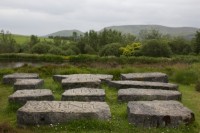 There are many striking inscriptions and sculptures, not least the one overlooking the lochan (small loch) set out on eleven large stones saying ‘The present order is the disorder of the future. Saint Just’. Equally dramatic is the stone byre converted into a temple to Apollo with Corinthian and Ionic columns painted onto the front with an inscription ‘To Apollo, his music, his missiles, his muses’ set in one of the more homely elements of the garden the temple pool garden, with a gorgeous lily pond in front of it.
There are many striking inscriptions and sculptures, not least the one overlooking the lochan (small loch) set out on eleven large stones saying ‘The present order is the disorder of the future. Saint Just’. Equally dramatic is the stone byre converted into a temple to Apollo with Corinthian and Ionic columns painted onto the front with an inscription ‘To Apollo, his music, his missiles, his muses’ set in one of the more homely elements of the garden the temple pool garden, with a gorgeous lily pond in front of it. Wandering through the wild area by the lochan I came across all kinds of carved inscriptions such as ‘The world has been empty since the Romans. St Just’ (him again). True, but they never got as far as South Lanarkshire; the Antonine Wall is some way south. One of the most charming elements is the series of small flowerpots on a stone shelf, each one with the name of a female French revolutionary and on the wall of the house behind the caption ‘Les femmes de la Revolution’.
Wandering through the wild area by the lochan I came across all kinds of carved inscriptions such as ‘The world has been empty since the Romans. St Just’ (him again). True, but they never got as far as South Lanarkshire; the Antonine Wall is some way south. One of the most charming elements is the series of small flowerpots on a stone shelf, each one with the name of a female French revolutionary and on the wall of the house behind the caption ‘Les femmes de la Revolution’. 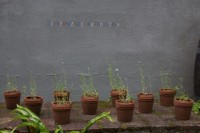 The house isn’t lived in any more which is a pity and the whole place is quite low key – the lady taking the money sells a few postcards and pamphlets but trade was slow. She did have time to answer my question about the little wooden sign round the back which didn’t look as if it had the mark of the great man about it, saying ‘Morris : Finlay’. Something to do with two great artists perhaps?
The house isn’t lived in any more which is a pity and the whole place is quite low key – the lady taking the money sells a few postcards and pamphlets but trade was slow. She did have time to answer my question about the little wooden sign round the back which didn’t look as if it had the mark of the great man about it, saying ‘Morris : Finlay’. Something to do with two great artists perhaps? 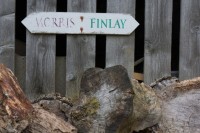 No, it was to direct the heating oil delivery men to the correct tanks for this and a neighbouring households winter fuel supplies.
No, it was to direct the heating oil delivery men to the correct tanks for this and a neighbouring households winter fuel supplies.
June 29, 2015
The summer solstice passed a week ago, even Glastonbury is over, but this year’s elderflower is only just going over now. Its been a cool spring and early summer and there has been a particularly bountiful crop. Now I have a demi-john of the stuff bubbling away in the kitchen, slightly to the amazement of visitors who mostly guess correctly that it is wine-in-the-making, but hardly ever guess that it is elderflower. 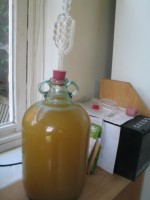 Elderflower really is the queen of flower wines. The aroma when it is mashing is divine and fills the whole house, and the wine itself is one of the most refreshing and distinctive I know. Of course elderflower don’t have to be used to make wine – the cordial ain’t bad either.
Elderflower really is the queen of flower wines. The aroma when it is mashing is divine and fills the whole house, and the wine itself is one of the most refreshing and distinctive I know. Of course elderflower don’t have to be used to make wine – the cordial ain’t bad either.
Actually I’ve branched into something new with them this year too – elderflower frittata. Picking the flowerlets before breakfast and then collecting the eggs (such willing hens….) what could be better. So good indeed that it has ended up as a recipe in my forthcoming book The Cowley Road Cookbook, where foraged ingredients play more than just a walk on part.
But back to elderflower wine. After three days mashing, it take at least another month before the contents of the demi-john are fully fermented. Then its time to bottle. And after a few months, drink. My friends Jo and Eric reckon if you can keep some till after the flower burst the next year there is a particularly flowery aftertaste. I’m sure they are right. Its just I never seem to have any last that long!
May 29, 2015
Spring has arrived and with it my Airbnb guests. I had my first ever visitors from Vietnam earlier this week, business student Phuong and her dad Son, visiting her from Saigon. On arrival I mentioned to them that I needed to go out to my allotment shortly to tend to my vegetables. The comment produced an outpouring of enthusiasm. ‘How wonderful – could we come with you?’ This is definitely the first time guests have expressed such enthusiasm, mainly the questions are on the easiest way to get to Bicester Village or which colleges the Harry Potter films were shot in. But of course the tradition of home vegetable growing especially the much prized ‘private plots’ allowed under communism, have a strong resonance – especially as they constituted about 1% of the cultivated land but produced 25% of the food in many communist regimes. They were suitably delighted to discover how close the allotment was – they had assumed a lengthy bus ride rather than a five minute walk.
On arrival Son and Phuong were clearly amazed at the lushness of it all, especially the range of flowers on some plots, which did look rather beautiful in the evening sun. An inspection of my plot followed – the source of greatest surprise being rhubarb, a totally new concept to them.The garlic came in for approval but I was stumped by their questions about ‘black garlic’ something I’ve never seen nor heard of. After a quick visit to my space in the shared poly tunnel where they admired the basil and tomatoes making great progress in a rather chilly May, the final stop was the orchard plot. This produced the strongest reaction. Cherries just netted against the birds, and apples and pear blossom just setting were viewed with reverence and delight.
As we came to leave I pulled some of the rhubarb, just as a typical English rainstorm loomed, and we took it home and stewed it with dried fruit and served with yoghurt. So Saigon will now be regaled with tales of the strange fruit they grow on those British ‘private plots.’
May 4, 2015
At last a bit of rain! So I was off to the orchard plot on my allotment to scythe the rapidly growing grass under the fruit trees. Some damp on the grass works a treat and my two handled scythe from Simon Fairley of Tinkers Bubble cuts through the new growth like a knife through butter in these conditions.
But before I’d even reached the plot and commenced scything, two fellow allotmenteers had accosted me and made jokes about my resemblance to Aidan Turner (not) and his scything in ‘Poldark’. So controversial! Not everybody agreed with his style which certainly looked more like hacking at the grass than scything as I understand or practice it and debates have raged in media ranging from the ‘Daily Telegraph’ (see link) and Patrick Gore-Langton in the ‘Daily Express’ to the News Quiz.
As for me.. well the scything was going just fine until the rain came down again with about a third done. So its the shirt-on Ross Poldark look-alike(ish) up on the plot again later in the week.
February 27, 2015
China may be associated with large-scale, commercial agriculture, but on my trip there in 2014 I was delighted to discover that ‘Bio Farm’ in Shanghai is bucking that trend. Founder Jane Tsao (pictured) 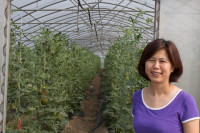 set up this small farm in the eastern suburbs of the city in 2004, and it gained organic certification a year later. She now employs about 60 staff and together they grow a range of fruit and vegetables including salad crops, tomatoes, spinach, water melon, figs, strawberries and peaches. The farm manages to stay economically viable by selling its produce to high-end restaurants in Shanghai. This is combined with a community supported agriculture (CSA) scheme with approximately 400 subscribers.
set up this small farm in the eastern suburbs of the city in 2004, and it gained organic certification a year later. She now employs about 60 staff and together they grow a range of fruit and vegetables including salad crops, tomatoes, spinach, water melon, figs, strawberries and peaches. The farm manages to stay economically viable by selling its produce to high-end restaurants in Shanghai. This is combined with a community supported agriculture (CSA) scheme with approximately 400 subscribers.
Bio Farm is linked to Garden Organic though the International Federation of Organic Agriculture Movements (IFOAM), and it uses a range of its educational materials. The team run a ‘grow your own’ education programme and a ‘Bio Farmers Kitchen’, where CSA members and farmers can prepare and cook their food. The day that I visited, its volunteers were preparing open up the farm for a ‘tomato day’ to encourage more visitors.
Jane sees plenty of room for growth in the organic sector in China. “It’s a rather elite niche at the moment,” she says. “But we love and need reliable, safe food in China and we are proof it can work right here in Shanghai.” The biggest problem Bio farm faces is development pressure. This five-acre patch of greenery is right beside a main road and surrounded by factories, offices and suburban housing. Local developers are already arguing that the farm is an inefficient use of space.
This post first appeared as an article in The Organic Way no 213 Spring 2015
December 31, 2014
Jans Ondaatje Rolls ‘The Bloomsbury Cookbook’ (Thames and Hudson) is as much social history as cookbook. The ‘Bloomsberries’ may have been the foodies of their day, but were profoundly ignorant of all aspects of food production and preparation. The book combines food related paintings, prose and gossip, with recipes, to provide a very human portrait of this much studied Group.
From a very different perspective and taking a much longer historical sweep, Margaret Willes in ‘The gardens of the British working class’ (Yale University Press) focuses more on the struggles of creating a ‘blessed plot’ from cottage gardens and allotments. She brings it to life through the words of people such as Joseph Turrill, small time market gardener and diarist who was a neighbour of Lady Ottoline Morrell in Garsington. A horticultural history of the people who latterly were employed as the cooks and gardeners to the intellectuals.
This post first appeared as an article in The Guardian ‘readers books of the year 2014’, on 27 December 2014.
December 22, 2014
It was so wet and gloomy that an afternoon invitation to see HRH Prince Charles open the new Heritage Seeds Kitchen Garden at Le Manoir aux Quats Saisons a few weeks ago was potentially something of a mixed blessing. In the event the mud won out and the guests were confined to quarters – or Quats as it seems to be known locally – the drawing room of the Le Manoir. His Maj toured with an excited Raymond Blanc (‘RB’ to the staff), Anne Keenan the garden designer, David Love Cameron the head gardener and of course Garden Organic’s CEO, James Campbell. Quite enough, once the security guys had done a once over to check for anything untoward, to turn the place into a fairly accurate replica of the Somme. Especially after the formal planting of an apple tree to commemorate the visit. It turned out to be an F1 hybrid – not very organic, so someone will have to slip out and buy a replacement when nobody important is looking. Much more salubrious chatting in front of the log fire to Garden Organic’s Vice President’s Susan Hampshire and Thelma Barlow (from Coronation Street) both of whom are real gardening experts and organic growing enthusiasts.
Eventually the royal party pitched up, shaking the rain from the coats and umbrellas and joined us for tea. When having tea with royalty what to talk about? ‘Have you come far?’ No, that is what they supposedly ask us. Well we have corresponded about keeping chickens in the garden in the past – something which has led to Garden Organic’s Hens@home project (see my blog post of 8 April 2014) so I tried my luck. Bingo, the Royal face lit up and soon the conversation was not only about hen keeping but the merits of keeping a pig in the back garden as well. Great way to reduce food waste he assured me. Don’t tell DEFRA! Perhaps the ‘black spider’ already has.
And what was the tea like you ask? What you got was great – how could it be otherwise at Le Manoir, but there was so little that I’m sure the hens, let alone any piggy waiting patiently outside for any scraps, died of starvation years ago.
 Lord and Lady Muck and friends got to visit on the afternoon of the final day. A beautiful, sunny, and cold day.
Lord and Lady Muck and friends got to visit on the afternoon of the final day. A beautiful, sunny, and cold day.  The church itself, hardly ever open to the public – some of the structure isn’t safe, is a bleak reminder of the horrors of war visited upon a city that suffered more than its fair share of bombing 75 years ago.
The church itself, hardly ever open to the public – some of the structure isn’t safe, is a bleak reminder of the horrors of war visited upon a city that suffered more than its fair share of bombing 75 years ago. ‘Girl with a trumpet’ was one of their star turns (you can check out the actual performance on You Tube) and they performed a couple of Bill Withers numbers too (as in, ‘how do you turn in a duck into a great blues musician?’ ‘You put it in the microwave till its bill withers’) but the one that touched our hearts was ‘My Victorian boy friend’.
‘Girl with a trumpet’ was one of their star turns (you can check out the actual performance on You Tube) and they performed a couple of Bill Withers numbers too (as in, ‘how do you turn in a duck into a great blues musician?’ ‘You put it in the microwave till its bill withers’) but the one that touched our hearts was ‘My Victorian boy friend’. A temple to allotment sheds world wide, right there in the Temple Church.
A temple to allotment sheds world wide, right there in the Temple Church.







